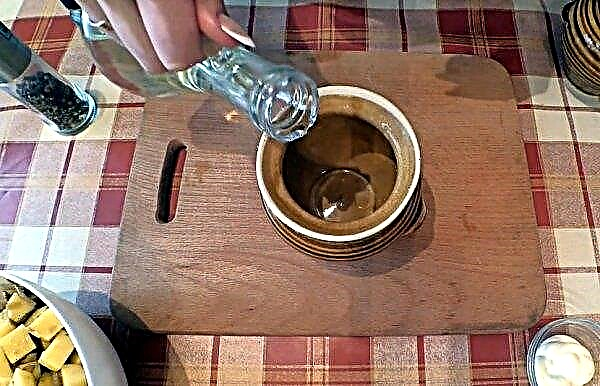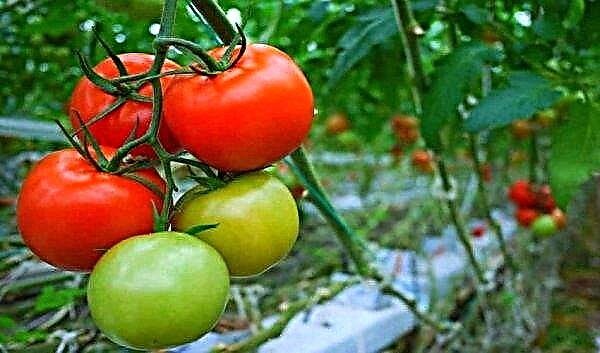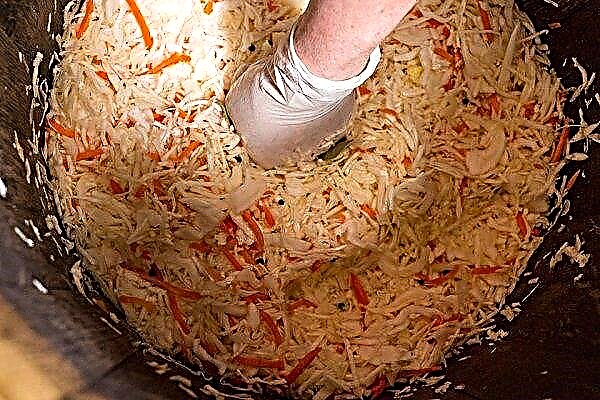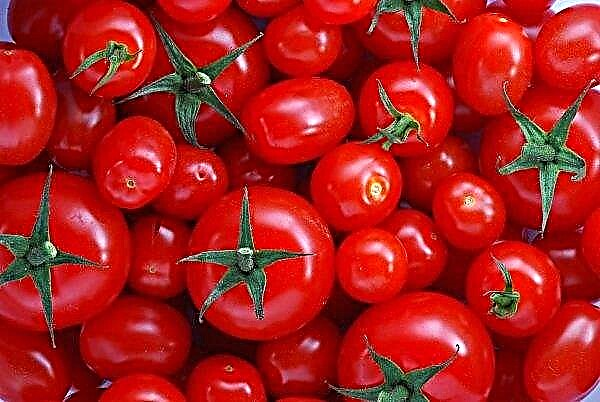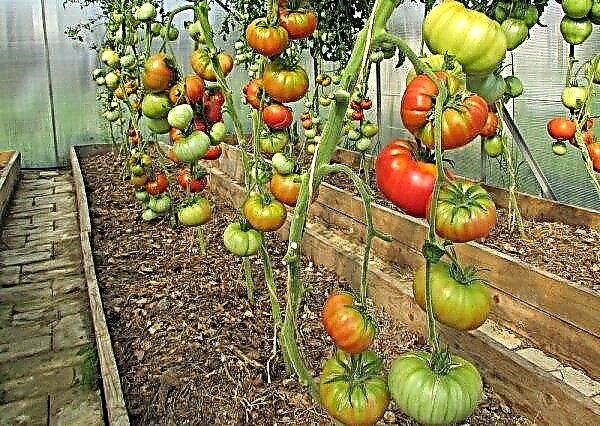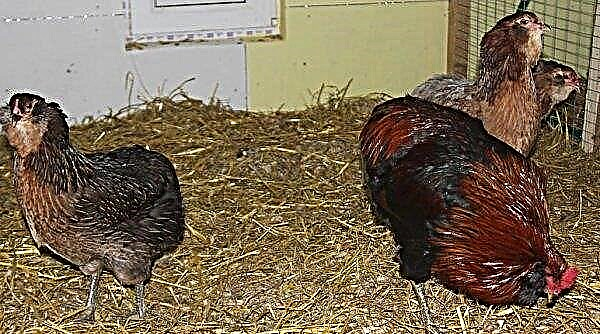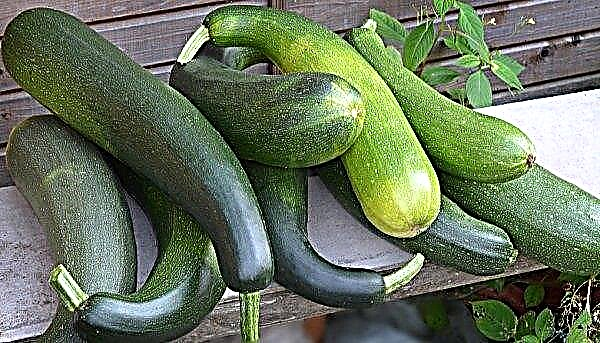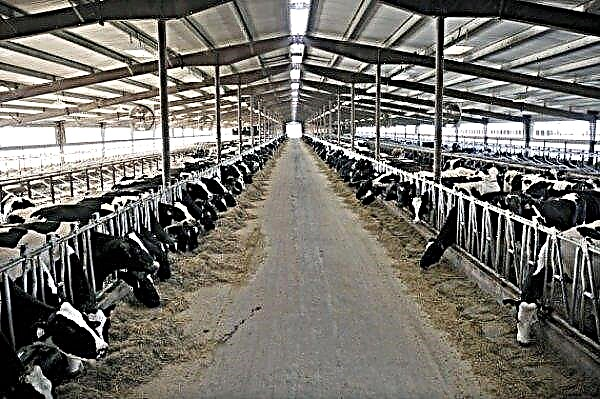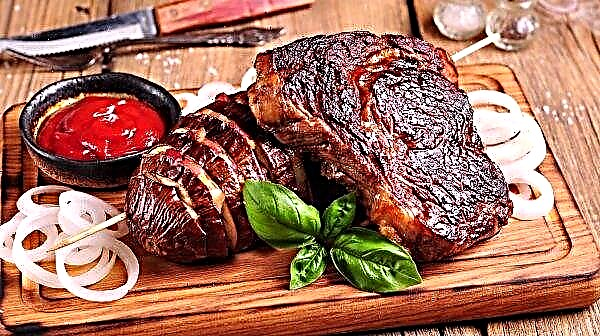Outdoor terrace in the country - a great place to relax in the fresh air. To ensure that the floors on the veranda always look attractive and last for a long time, before putting the premises into operation, they must be properly painted. The requirements for flooring, its types and description of the painting technology are described further in the article.
Material requirements for wood flooring
Wood is one of the most environmentally friendly decoration materials. It is strong, easy to process and durable. But due to external factors, the life of wooden floors is reduced. The flooring on the open veranda should be treated with some kind of paintwork.
Did you know? The most useful, even medicinal, consider the floors of pine or juniper wood. Thanks to essential oils, the material purifies the air and saturates it with useful volatile products.
The coating should protect the board from the following factors:
- fungi and insects;
- moisture;
- cold;
- fire.

Fixed structures in the fall and winter are exposed to moisture and frost. This over time leads to deformation and loss of wear resistance. In addition, moisture contributes to the development of fungi that soften the floor into dust. Bark beetles also reduce their lifespan by eating holes and whole tunnels in wooden decks. It will not be superfluous to protect against accidental fire in the presence of a fireplace.
Another important nuance - you need to choose a paint for the type of wood. There are varnishes and impregnations on sale that imitate the color and texture of the types of wood used in construction. Therefore, if you do not want to lose the natural appearance of the board, but only to strengthen and emphasize the structure of the flooring, give preference to such materials. If desired, the color of the floor can be made harmonious with respect to the interior, terrace furniture.

Types of paints and varnishes
When choosing a material, you need to pay attention to its composition. For open rooms, it is better to purchase products with enhanced moisture and heat resistance. Most often, such materials require pre-treatment - applying a primer layer. For the home, water-based products are recommended, quick-drying and not distinguished by a pungent odor. Among other things, for indoor use, a material with a gentle composition should be chosen, since many varnishes have toxic components.
Did you know? There is no exact data on the occurrence of the word "veranda". But one version says that it is of Indian origin and indicates a place that leads from the house out.
Impregnation
Impregnation by protective properties are divided into antiseptics and flame retardants. The former protect the tree from fungi, rot, viruses and insects. They repel moisture, prevent the torsion of the board, its cracking. The second ones are protected from thermal effects due to strong heating or accidental ingress of sparks from fire. There are combined impregnations that combine both functions.

For internal work use water-based products. The product dries quickly, non-toxic, easy to apply. Impregnation from volatile organic solvents at the base of the composition dries for a long time, but does not leave a heavy odor and gives the board a deep and rich shade. For open and unheated terraces, oil impregnation is often used. It has a strong film, which increases the service life, especially in cold conditions. However, such a tool dries for a long time and smells sharply.
Butter
There is a special terrace oil for sale. The product creates a dense layer on the surface to be painted, which protects well from moisture. This material is also used on marinas for light boats. Oils are made from natural ingredients, which significantly increases their cost. Synthetic oils with polyurethane added. The latter are cheaper, but inferior in terms of ecology.
 For the floor of the open terrace, oil with the addition of pine resin is recommended. The material is highly resistant to external factors and gives the wood a darker shade.
For the floor of the open terrace, oil with the addition of pine resin is recommended. The material is highly resistant to external factors and gives the wood a darker shade.
Paint
Acrylic enamel is resistant to moisture and ultraviolet. Such a composition is used in places open to the sun, often used for painting ship linings. The material is flexible, withstands temperature extremes. The paint lies evenly, dries quickly, does not have a pungent odor, which allows it to be used indoors.
Chlorinated rubber enamel is a good choice for floors with slight aesthetic defects. The dense, opaque layer hides all the bumps. It is recommended that the surface be treated before applying the primer. One of the main advantages of the composition is wear resistance.
 Alkyd paints can be transparent or matched in color. The composition has antifungal components, which allows you to use the product in conditions of high humidity. Additive resins cover the tree with a beautiful gloss. The coating does not tolerate aggressive care products; floors can only be cleaned with clean water.
Alkyd paints can be transparent or matched in color. The composition has antifungal components, which allows you to use the product in conditions of high humidity. Additive resins cover the tree with a beautiful gloss. The coating does not tolerate aggressive care products; floors can only be cleaned with clean water.
Lacquer
For wooden flooring of a country house of an open type, varnish with an organic solvent is used on the veranda. The tool is resistant to scratches and other minor damage from furniture. The varnish has a high resistance to moisture and heat.
One of the strong and durable coatings is considered yacht varnish material. The alkyd-urethane mixture penetrates into the deeper layers of the wood, filling all cracks, practically “preserving” the surface. Water-based varnish is suitable for flooring in a heated, covered veranda. The composition is environmentally friendly, non-toxic, does not have a pungent odor. It can be used not only on floor coverings, but also on walls.Important! Paint with a solvent in the composition is necessary in a respirator: fumes are toxic to humans.
 Epoxy varnish is considered the most resistant to mechanical damage, temperature and humidity changes. Resin is present in the composition, which protects the wood well, gives shine and increases the service life. The material is characterized by prolonged drying and toxicity, suitable only for open rooms.
Epoxy varnish is considered the most resistant to mechanical damage, temperature and humidity changes. Resin is present in the composition, which protects the wood well, gives shine and increases the service life. The material is characterized by prolonged drying and toxicity, suitable only for open rooms.
Floor painting technology
Depending on the selected material, choose tools for preparatory work and direct application of paint. You may need to disassemble the structure, grind it.
Such tools and materials are useful for work:
- rags;
- brushes and / or rollers;
- paint tray;
- nail clipper;
- assembly hammer;
- pliers, ticks;
- stiff brush or scraper;
- sandpaper / grinder;
- White Spirit.

Surface preparation
To paint new floors, the preparation consists in drying the boards well.
Important! If the selected paint requires it, apply a layer of primer or light impregnation (under the varnish). After priming, the surface must be sanded again.
If the flooring was previously painted, the sequence of actions is different:
- Disassemble with tools, carefully, taking care not to damage the components.
- Use white spirit to dissolve the old coating.
- When it starts to bubble, remove with a scraper.
- Walk on the cleaned surface with a grinder, sweep away the trash.
- Leave the boards to dry under a canopy in a ventilated place (time depends on the weather and the thickness of the wood).

Dyeing
Depending on the composition, work is carried out either with a brush or with a roller. For convenience, the material is poured in portions into a special pan. Apply with wide strokes, shading the first layer as much as possible. You need to paint in the direction of the length of the board. After the first layer, leave to dry for the time required according to the instructions for the material. In order for the coating to last for a long time, it is recommended to paint in several layers. In addition, each layer should ideally dry.
Did you know? The Italian city of Venice, standing on the water, was built using alder wood and larch.
Further care
Paul will last for a long time, if it is properly used, to carry out proper care. On light paintwork, the presence of heavy furniture is undesirable. This must be taken into account immediately, so as not to hide the deformation of the surfaces. Difficulties in care, in principle, no, but we must remember that painted flooring does not tolerate aggressive household chemicals. For washing, it is better to use a mild liquid soap or just plain water. It is not necessary to pour liquid on a covering, the rag should be wrung out well. If water gets between the boards, it is fraught with rotting and fungi.

An outdoor summer wooden veranda or terrace is sheltered for the winter. One of the popular inexpensive options are street curtains. They are good in that they do not close the view from the windows if the room adjoins them. Curtains are easily twisted and installed. In this case, the floors are covered with tarpaulin or dense polyethylene. If the entrance area is laid on top of several rugs, so as not to slip on the film.
Wooden floors on the terrace or veranda require good coverage and careful maintenance. The more resistant the paintwork to the influence of the external environment, the longer the coating will last.

